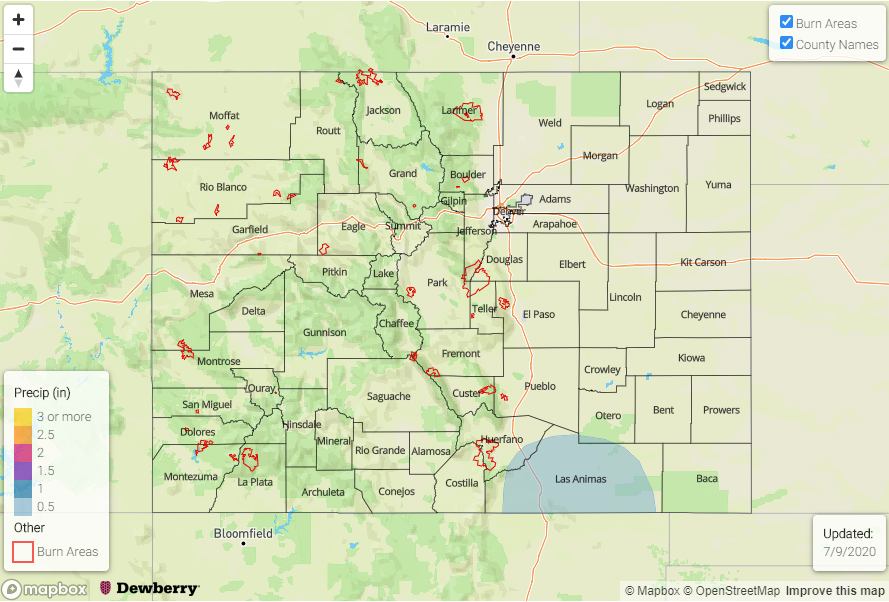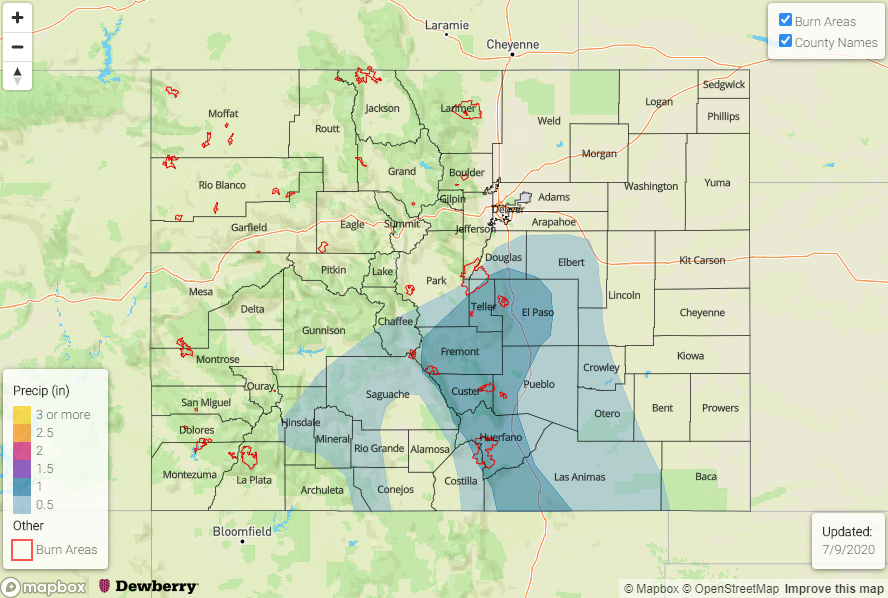Issue Date: Monday, July 6th, 2020
Issue Time: 2:25PM MDT
Valid Dates: 7/7– 7/21

Temperatures are on the rise with a moderately strong ridge overhead, and dry air is beginning to settle in across the state. This can be seen in the water vapor imagery below by the yellow shades over Colorado. Tomorrow will be the last shot at some weak thunderstorms and showers as the trough (orange “X”) transitions east and propagates some mid-level energy across the state. Due to the lack of boundary layer moisture, storms are likely to produce more wind than rainfall. High fire danger will return to western Colorado, the western mountains, and portions of the Southeast Mountains as southwest surface winds are expected to increase and couple with low relative humidity values. The best chance for wetting rainfall will be east of the mountains across the adjacent plains where a little better low-level moisture should exist.
Behind the trough, the heat is on as the ridge rebuilds over the state and westerly flow continues to scour out any of the remaining moisture. This is likely to be our first real heat wave of the summer with highs reaching the upper 90Fs to 100F across all the lower elevations by tomorrow. There may be some weak cooling on Thursday, but it will hardly be noticeable with highs still in the 90Fs. The extreme heat is expected ramp right back up, and temperatures over the eastern plains will push 105F by the week’s end. Expect the heat to last through the weekend.
Storm chances return Sunday into Tuesday (Event #2), which should help some lucky areas cool off during the afternoon over south, central Colorado. The increase in storm activity occurs due to the ridge axis shifting slightly east, and moisture wrapped around the High moving over the state. There looks to be a (potential) tropical cyclone that forms over the eastern Pacific and travels northward along the Baja Peninsula. This could help pull some decent moisture northward on the west side of the high, so this interaction with the High and storm track/intensity of the potential TC will be watched closely throughout the week.

I’ve added the 10th percentile climatology to the GEFS PW plumes below to show just how dry it’s going to get on top of the heat. Record low values will be possible over western Colorado, which is not good news as this area is already experiencing a drought. PW also drops off significantly over eastern Colorado as well and hovers around the 10% climatology by Wednesday morning. All in all, please use extreme caution as fire danger will be elevated with already dry fuels and very hot temperatures forecast. The nice ramp up in moisture can be seen at the end of the week, and there is pretty good consensus among the different model members this far out. Saturday may allow for a few scattered storms over the southern mountains, but the boundary layer will still be quite dry, so not expecting much rainfall.

Event #1: Tuesday (7/7)
No Apparent Threat as the trough pushes some mid-level energy overhead and it mixes with limited low-level moisture to produce scattered storms over eastern Colorado.
The boundary layer is expected to be even more dry tomorrow, which will really rainfall efficiency with most of the droplets evaporating before the reach the surface. There is a slight chance that rain totals could reach 0.50 inches along the Raton Ridge, but this would be very isolated in nature. Small hail is also not out of the question under one of these stronger storms. Storms that are able to form tomorrow will likely produce gusty outflow winds and lightning, which seems to be the main threat from storms lately. Flooding is not expected so there is No Apparent Flood threat issued. A Red Flag Warning has been issued for western Colorado with a Fire Weather Watch for the majority of the mountains. Tune into your local NWS office and tomorrow’s FTB for more information.

Event #2: Sunday – Tuesday (7/12 – 7/14)
No Apparent Threat as moisture gets wrapped northward around the High and moves into the state with a slight eastward shift of the ridge axis.
After a very dry and hot week, moisture begins to return to the state on Saturday. It still looks to be pretty dry over western Colorado, so expect storms to be confined to the Central and San Juan Mountains along and near the Continental Divide starting on Sunday. Better storm formation is expected over the Southeast Mountains and southern Front Range. Without much upper dynamical support, storms will likely be pulse-like in nature. A few may wander into the immediate adjacent plains with the counterclockwise flow, which is typical with this diurnally driven pattern. If any shortwaves arrive at peak heating, coverage of storms will likely increase over the eastern mountains and over the immediate adjacent plains, but it’s too far out to know any of those details yet. As for the rainfall chances, best guess now is that coverage will be greatest further south and east. As is typical, the GFS has a lot more moisture than the ECMWF, so we’ll continue to watch model trends throughout this week.
